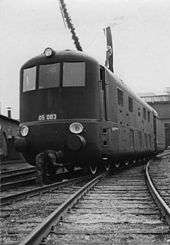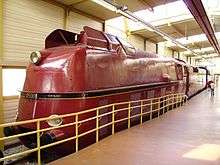DRG Class 05
The Deutsche Reichsbahn's Class 05 was a German class of three express passenger steam locomotives of 4-6-4 wheel arrangement in the Whyte notation, or 2′C2′ h3 in the UIC notation used in continental Europe. They were part of the DRG's standard locomotive (Einheitslokomotive) series.
| DRG Class 05 DB Class 05 | |
|---|---|
 05 001 Brockhaus 1938 | |
| Number(s) | 05 001-003 |
| Quantity | 3 |
| Manufacturer | August Borsig Werke (Berlin-Tegel) and Borsig Lokomotiv Werke (Hennigsdorf) |
| Year(s) of manufacture | 1935, 1937 |
| Retired | 1958 |
| Wheel arrangement | 4-6-4 |
| Axle arrangement | 2′C2′ h3 |
| Type | S 37.19 |
| Track gauge | 1,435 mm (4 ft 8 1⁄2 in) |
| Length over buffers | 26.265 m (86 ft 2 in) |
| Height | 4.45 m (14 ft 7 in) |
| Empty weight | 118.5 t (116.6 long tons; 130.6 short tons) |
| Service weight | 129.9 t (127.8 long tons; 143.2 short tons) |
| Adhesive weight | 57.7 t (56.8 long tons; 63.6 short tons) |
| Axle load | 19.4 t (19.1 long tons; 21.4 short tons) |
| Top speed | 200.4 km/h (124.5 mph) |
| Indicated Power |
|
| Driving wheel diameter | 2,300 mm (90.55 in) |
| Leading wheel diameter | 1,100 mm (43.31 in) |
| Trailing wheel diameter | 1,100 mm (43.31 in) |
| Valve gear | Walschaerts (Heusinger) |
| No. of cylinders | 3 |
| Cylinder bore | 450 mm (17.72 in) |
| Piston stroke | 660 mm (25.98 in) |
| Boiler Overpressure | 20 bar (2.0 MPa; 290 psi) (reduced to 16 bar (1.6 MPa; 230 psi) in 1950) |
| No. of heating tubes | 106 |
| No. of smoke tubes | 24 |
| Heating tube length | 7.0 m (23 ft 0 in) |
| Grate area | 4.71 m2 (50.7 sq ft) |
| Radiative heating area | 18.5 m2 (199 sq ft) |
| Superheater area | 90 m2 (970 sq ft) |
| Evaporative heating area | 255.52 m2 (2,750.4 sq ft) |
| Tender | 2'3T37St |
| Water capacity | 37,000 L (8,100 imp gal; 9,800 US gal) |
| Fuel | 10 t (9.8 long tons; 11 short tons) |
Pre World War II history
Since the success of the diesel high speed trains like the Flying Hamburger in the middle of the 1930s, the German locomotive industry turned to faster steam locomotives. After speed tests with a streamlined DRG Class 03 the Borsig locomotive factories[lower-roman 1] produced three engines:
- 05 001 in 1935, streamlined,
- 05 002 in 1935, streamlined, world speed record in 1936
- 05 003 in 1937, cab forward streamlined.[1]
The locomotives did regular service in FD express passenger trains, e.g. FD 23 from Hamburg to Berlin. The design speed was 175 km/h (109 mph). In 1944, the streamline plates were removed. 05 003 had been rebuilt and lost the cab forward design.
World high speed records
05 001 and 05 002 were mainly used for test runs from 1935 to 1936. Most of these runs were made on complete journeys between Hamburg and Berlin. On 7 June 1935 the 05 002 made a top speed of 191.7 km/h (119.1 mph) near Berlin. The same engine made six more runs with more than 177 km/h (110 mph) with trains up to 254 t (250 long tons; 280 short tons) weight. On 11 May 1936 it set the world speed record for steam locomotives after reaching 200.4 km/h (124.5 mph) on the Berlin–Hamburg line hauling a 197 t (194 long tons; 217 short tons) train. The engine power was more than 2,535 kW (3,399 ihp)). This record was broken two years later by the British LNER Class A4 4468 Mallard engine on a slightly downhill line. This record was set between Little Bytham and Essendine in South Lincolnshire.
On 30 May 1936 the 05 002 set an unbroken start stop speed record for steam locomotives: During the return run from a 190 km/h test Berlin-Hamburg it did the ~113 kilometres (70 miles) from Wittenberge to a signal stop before Berlin-Spandau in 48 min 32 s, meaning 139.4 km/h (86.6 mph) average between start and stop.
Post-War history
After World War II, the three engines came to the engine shop in Hamm, Westphalia. Since there were only three specimens of the 05, DB thought to scrap them. But then the engines were sent to Krauss-Maffei to be restored. 05 003 went into regular service in 1950, the other two in 1951. Boiler pressure was reduced to 16 bar or 230 psi, hence the engines lost some of their old power. All three locomotives were used to haul express trains until 1958.
Mostly the 05 hauled the FD (long distance express) trains "Hanseat" and "Domspatz" on the run Hamburg - Cologne - Frankfurt. The regular top speed of the trains was 140 km/h (87 mph). On this 703 km (437 mi) run the 05 operated trains did the longest run with steam traction in the DB network. July 1958 the 05 were replaced by the diesel-hydraulic DB class V 200.
05 001 went to the Verkehrsmuseum Nürnberg, where it can be seen streamlined in large parts - the drivetrain on the right hand side remains visible - in its original red livery. The other two locomotives were scrapped in 1960.
Picture gallery
 05 001 on delivery
05 001 on delivery The streamlined cabforward 05 003
The streamlined cabforward 05 003 05 001 in the Nuremberg Transport Museum
05 001 in the Nuremberg Transport Museum
Notes
- The Borsig factory was moved from Tegel to Hennigsdorf after the takeover of Borsig by AEG, and production took place at both sites.